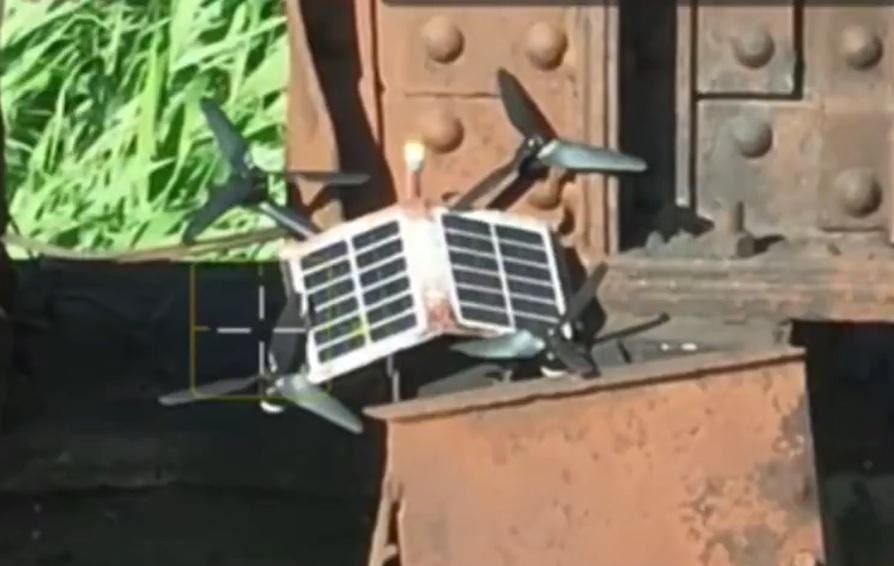Russia Deploys Solar Powered Ambush Drones

A Russian improvised solar drone seen in the Kherson region
Drone video from near the Dnipro bridge in Kherson region shows a Russian FPV with an unusual modification: a sheet of solar cells draped over the body. This is a clumsy setup using available materials, but it may be the first battlefield example of a new type of drone, one that can wait in ambush indefinitely.
An Upgrade For Ambush Drones
As we have seen, FPV attack drones are increasingly used for ambushes. The operator lands their FPV by the side of a track or on a rooftop and waits for possible targets, alerted either by a spotter drone or using the drone’s own camera. When one arrives, the drone takes off and goes in pursuit.
A Ukrainian ambush drone spots a Russian Bukhanka logistics van
The latest ambush FPVs are equipped with landing legs or skids so they can see over grass or other vegetation while landed.
Fiber drones seem to be popular for ambush attacks, because the connection via a fiber optic cable uses less energy than maintaining video contact. This extends battery life so they can wait for longer.
The Russians have also described a version of the Joker FPV able to hibernate, going into a sleep mode for days or weeks before being activated. There are no confirmed sightings of these in the field.
Using solar power to keep the battery topped up potentially allows a drone to lie in ambush and watch for an extended, if not indefinite, period.
Solar Powered Lurkers
As OSINT analyst DanielR notes on a Twitter/X thread about the solar drone, there are a vast number of lightweight solar charging panels on the market. Carry one over your backpack and you can charge phones and other devices as you hike. They typically cost under $50, like this 5-watt unit weighing less than half a pound and are easily small enough to fit on a drone.
Portable solar panel kit for charging phones and other devices.
Such a unit should yield 15-45 watt-hours of energy per day, though this is wildly variable depending on conditions. An FPV may consume more than 100 Watts while flying, on the ground it may require as little as 7 Watt-hours per day so the solar charger can maintain it indefinitely in dormant mode. Keeping the camera and other electronics on will take 5 Watts or so, so a drone can stay ‘awake’ for as long as the sun shines.
That may be the intention here.
“Using it to charge the battery is troublesome given the voltages involved,” DanielR told me. “Instead, it’s probably just connected to the 5-volt bus, which powers VTX and camera, without any additional circuitry.”
Effectively the solar cell allows the drone to act as a CCTV sentry during daylight hours, saving battery power for when a target is spotted.
Solar Hopper Drones
The Aqua Quad is a U.S. Navy project for a floating, solar powered quadcopter
Rigging up drones with commercial solar cells is easy enough, and there have been a huge number of projects in this field, from a ‘simple weekend project’ for hobbyists to build their own solar-powered quadcopters, to serious industrial and academic efforts like this 2022 study from the University of Washington which built a multicopter with folding solar cells and software to pick suitable landing sites. The drone could recharge in three hours and then fly for five minutes, making repeated short flights over long distances.
The U.S. Navy’s Aqua-Quad project is a similar concept, but with a floating drone carrying sonar sensor for submarine hunting. Swarms of Aqua-Quads could travel the seas like fleets of mobile sonobuoys.
A CX10 toy drone fitted with 40 tiny ultra lightweight solar panels by the JKU team adding only .25% … More
The technology is becoming increasingly useful as solar cells become lighter and more efficient. When Researchers at the Johannes Kepler University Linz developed ultra-lightweight quasi-2D perovskite solar cells with a power output of up to 44 watts per gram in 2024, they demonstrated its effectiveness by attaching an array of cells to a CX10 toy quadcopter. The cells added just 0.25% to the drone’s weight but could fully recharge the batteries.
These hopper quadcopters are a long way being ‘eternal drones’ like the U.S. Navy’s Skydweller which can fly indefinitely on solar and battery power. But small drones with unlimited mission time on the ground are still useful – and it looks like they are already be in use.
Creeping Doom: The Solar Swarm
Solar powered drones could form high-tech ‘minefields.’ These could be operator-controlled, like the current generation of ambush drones, or be cued to automatically attack targets which they detect or which are located by other uncrewed sensors. A large minefield might send one or two drones up on periodic sweeps to check the surrounding areas.
The U.S Navy Skydweller drone is able to fly for weeks at a time powered by sunlight
And because they can keep recharging, solar drones can be sent on extended missions into enemy territory, creeping forward in hops a few miles at a time. They might be slow, but they can fly low and stealthily. They will be difficult to stop over an entire border or front line. How many miles to the enemy’s air base?
The recently sighted Russian solar drone sighting might not be very effective, and it is not clear just how much benefit the solar cells give and at what penalty to flight performance. The positioning of the cells certainly looks like they interfere with the thrust from the rotors.
But this clunky design may be the harbinger of another generation of FPVs with new and dangerous capabilities. The low cost and easy availability of all the necessary components means that drones can mutate fast, and any evolutionary successes – like fiber drones, which went from nothing to battle-winners in a year – may spread rapidly.
(For those wanting more on this topic, there is a whole chapter on solar power and other energy-scavenging technology for extended drone missions in my book ‘Swarm Troopers: How small drones will conquer the world)

